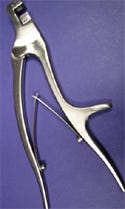Direct Metal Laser Sintering Speeds Prototype Development
DePuy Spine’s use of a DMLS system reduced wait times and increased flexibility in producing surgical tool prototypes
September 9, 2008
Originally Published MPMN September 2008
ENGINEERING SOLUTIONS
Direct Metal Laser Sintering Speeds Prototype Development
DePuy Spine's use of a DMLS system reduced wait times and increased flexibility in producing surgical tool prototypes
|
A DMLS system allowed DePuy Spine to quickly present consulting doctors with multiple iterations of surgical tool prototypes, such as this plate bender. |
As minimally invasive surgery becomes one of the fastest-growing areas in spine treatment, orthopedic surgeons are demanding increasingly sophisticated tools that must be designed for greater access and control through smaller incisions.
But getting these instruments to a surgeon who needs them—and coming up with new or customized models as techniques advance and materials evolve—can be an arduous process. DePuy Spine (Raynham, MA; www.depuyspine.com), a manufacturer of implants and instruments for spine surgery, found that prototyping, revisions, materials selection, cadaver testing, and manufacturing of surgical tools often amounted to total wait times of many months.
Hoping to reduce prototype lead times, DePuy acquired an EOSINT M 270 direct metal laser sintering (DMLS) machine, manufactured by EOS (Novi, MI; www.eos.info). Employing the machine during the past year has enabled DePuy to shrink lead times for surgical tool prototypes from several months to less than a week in some cases, according to Peter Ostiguy, DePuy staff team leader. “What has cut development time so dramatically lately is the capability of the M 270 to build multiple iterations of a tool prototype in a matter of days,” he says. The company has processed 2000 prototype parts of surgical equipment and devices on this type of machine in the first year of use alone.
The DMLS process begins with a CAD file of the product design, which defines each thin layer of a horizontal cross-sectioned model that is generated onto the work platform inside the machine. A first layer of 17-4 stainless-steel powder is deposited at a thickness of 20 µm onto the work platform and then sintered by a focused laser beam. The work platform is lowered and the process is repeated additively, layer by layer, until a 3-D metal part is produced with maximum dimensional limits of 10 × 10 × 8½ in. high. In this manner, extremely complex geometries are created automatically, directly from CAD data in just a few hours.
“In the early stages of DePuy’s product development, DMLS has helped by making new designs and functional prototypes available to their customer base of doctors much sooner,” says Andy Snow, EOS Northeast Area sales manager. “As a result, functional testing can be initiated quickly and flexibly. At the same time, these prototypes can be used to gauge the doctors’ acceptance.”
The consulting doctors can be very exacting about their requirements for tools such as blades, racks, tweezers, and calipers. “When they review the prototypes, they may ask for different handle angles or different spring strengths,” Ostiguy notes. “It’s very easy to adjust the CAD design and make another iteration. Laser sintering lets us make virtually anything they ask for.”
In addition to quicker prototype turnaround, the introduction of laser sintering into DePuy’s Development Center has also been a paradigm shift in the thought process for designing tools, according to Ostiguy. “We’re not designing for manufacturability any more, we’re designing for functionality,” he says.
Due to its success with DMLS for prototyping, DePuy recently purchased another M 270 for use with instruments for in vivo surgical applications.
Copyright ©2008 Medical Product Manufacturing News
You May Also Like


.png?width=300&auto=webp&quality=80&disable=upscale)
